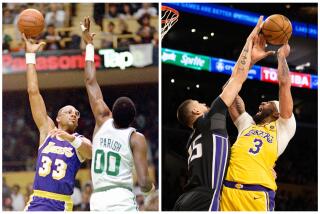Some In-Your-Face Action Could Lead to Eye Injuries
WASHINGTON — Keeping a close eye on the ball can lead to eye injuries, especially if athletes have more drive than ability.
The federal Consumer Product Safety Commission and the National Society to Prevent Blindness estimate about 100,000 sports-related eye injuries a year, according to a report in The Physician and Sportsmedicine, a medical magazine. Basketball and baseball are the leaders, with about 17% each.
In-your-face play increases the risk of injuring an eye -- yours or someone else’s.
“Close, aggressive contact produces most injuries in basketball,” said Dr. Bruce M. Zagelbaum, who wrote the report.
Zagelbaum, an ophthalmologist at North Shore University Hospital, Manhassett, N.Y., said typical injuries come from an opponent’s fingers, elbows or hands. These injuries include cuts in the lid, bruises around the eye, and scratches on the cornea, he said.
Most baseball injuries, on the other hand, come when the ball hits the eye, Zagelbaum said. Players under 15 are most likely to be hit by a pitched ball, largely because they may not have developed physically to the level needed for competition, he said.
The opposite may be true in racquet sports, which include racquetball and tennis. A well-hit ball can rocket at up to 140 m.p.h. A Canadian researcher found that experienced players are more likely than less-experienced ones to get hurt.
Most eye injuries are minor, although some are severe enough to cause blindness, Zagelbaum said.
Up to 90% of eye injuries can be prevented with proper eye protectors, which absorb impact force before it can damage the eye, the study said.
The best are made of a plastic called polycarbonate, which is stronger than glass or ordinary plastic. Look in the equipment for certification that it was designed to standards set by such groups as the American Society for Testing and Materials.
Also, make sure your gear is made for your sport.
Baseball batting helmets can include a polycarbonate face guard. “To my knowledge, no eye injury has ever occurred to a player wearing this device while playing baseball,” said Zagelbaum, who has studied eye injuries to major league players. Base runners with helmets need similar protection, and players in the field can wear polycarbonate eye protectors, he said.
Basketball and racquet sports players should use polycarbonate sports goggles with 3mm-thick lenses and unbreakable frames, Zagelbaum said. The lenses even come with prescription optics for players who ordinarily wear glasses, he said.
Fit is very important. The frame should cover the entire bony orbit in which the eye is held and should not bend in toward the eye under pressure, the doctor said.
But playing to win, without trying to kill, is also important. So is sharp defensive play, which can spot flying fingers before they gouge you, or find the ball before it strikes your head.
More to Read
Go beyond the scoreboard
Get the latest on L.A.'s teams in the daily Sports Report newsletter.
You may occasionally receive promotional content from the Los Angeles Times.










